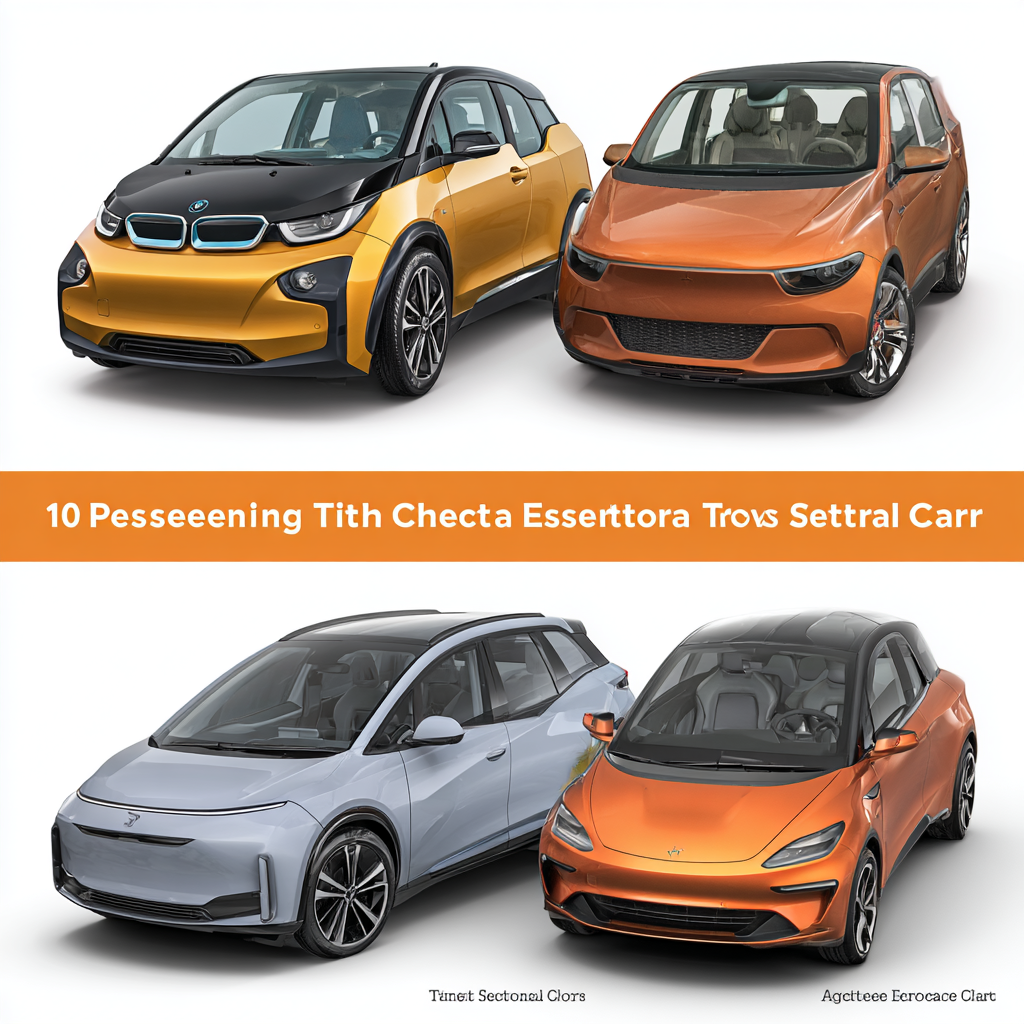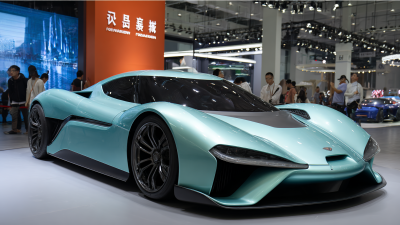10 Essential Tips for Choosing the Perfect Two Seat Electric Car
As the automotive industry witnesses a transformative shift towards sustainable mobility, the emergence of the "Two Seat Electric Car" segment captures the attention of eco-conscious consumers and urban dwellers alike. According to a recent market analysis by the International Energy Agency, sales of electric vehicles are expected to surpass 20 million globally by 2025, with compact designs like two-seat models leading the charge in urban environments. This reflects a growing consumer preference for efficiency and maneuverability, particularly in crowded city settings.

Industry expert Dr. Eva Johnson, a renowned automotive analyst, emphasizes the advantages of these vehicles, stating, "Two-seat electric cars are not just a trend; they represent the future of urban transportation, offering a perfect blend of sustainability and convenience." As the market continues to evolve, selecting the right two-seat electric car involves careful consideration of various factors, including range, charging infrastructure, and design aesthetics. With numerous options entering the market, this guide aims to equip potential buyers with essential tips to navigate their decision-making process effectively. In doing so, it highlights key aspects that contribute to the ideal purchase, ensuring that your choice aligns with both personal preferences and the broader goal of reducing carbon footprints.
Factors to Consider: Battery Range and Charging Infrastructure for Two Seat Electric Cars
When choosing the perfect two-seat electric car, one of the critical factors to consider is battery range. The range determines how far you can go on a single charge, which is essential for both daily commutes and weekend getaways. Generally, a higher battery capacity will offer a longer range, allowing for fewer stops at charging stations. If you frequently take longer trips, aim for electric cars that provide at least 150 to 200 miles of range, as this will give you peace of mind while driving without worrying about being stranded with a depleted battery.

Another pivotal aspect to evaluate is the availability and convenience of charging infrastructure. Consider the types of charging options you have access to at home, in your neighborhood, and along your regular travel routes. It's beneficial to invest in a model that supports fast charging capabilities; this can significantly reduce the time spent recharging. Additionally, check the accessibility of public charging stations in your area, as a robust network will enhance your ownership experience. Evaluating these factors thoroughly will ensure your choice aligns with your lifestyle and driving habits, making your electric car experience enjoyable and worry-free.
Evaluating Performance: Horsepower, Torque, and Acceleration Data for Electric Vehicles
When considering the performance of two-seat electric cars, examining horsepower, torque, and acceleration data is crucial. Horsepower is often the headline number that determines the car's ability to maintain high speeds and perform well on the highway. However, in electric vehicles (EVs), horsepower alone doesn't tell the complete story; it must be combined with torque, which provides the immediate pulling power needed for quick starts and overtaking maneuvers. EVs typically excel in torque delivery due to their electric motors, offering instant acceleration that can outpace many traditional combustion-engine vehicles.
Acceleration figures, particularly the 0-60 mph time, are essential metrics that showcase the car’s performance capabilities. The rapidity with which an electric car can reach highway velocities is indicative of its overall driving experience. Select models can achieve these speeds in under four seconds, significantly enhancing the thrill of driving. For consumers invested in performance, comparing these metrics across different two-seat electric options can help in selecting a model that not only fits their lifestyle but also satisfies their desire for speed and agility on the road.
Cost Analysis: Understanding the Total Cost of Ownership for Electric Cars
When considering the purchase of a two-seat electric car, it's crucial to understand the total cost of ownership (TCO). According to a report by the International Council on Clean Transportation, the lifetime costs of electric vehicles (EVs) can be significantly lower than those of traditional gasoline cars due to fewer moving parts and lower maintenance costs. On average, EV owners can save over $4,600 over the lifespan of the vehicle when compared to internal combustion engine (ICE) vehicles. This savings underscores the importance of analyzing not just the sticker price but also the long-term financial implications.

Tip: While evaluating your options, consider the charging costs as well. A 2020 report by the U.S. Department of Energy indicated that the average cost of electricity for EV charging is around $0.13 per kilowatt-hour, significantly cheaper than gasoline on a per-mile basis. This can lead to substantial savings, especially for daily commuters.
Furthermore, state and federal incentives can dramatically reduce the initial investment in an electric car. According to the U.S. federal tax credit, buyers can receive up to $7,500 off their taxes depending on the battery capacity. Evaluating these financial incentives is crucial for understanding the true cost of ownership and can significantly impact your decision when choosing the right two-seat electric vehicle.
Safety Ratings and Features: How to Assess the Safety Standards of Two Seat EVs
When considering the safety of two-seat electric vehicles (EVs), it’s crucial to start with the vehicle’s safety ratings. Various organizations, such as the National Highway Traffic Safety Administration (NHTSA) and the Insurance Institute for Highway Safety (IIHS), conduct comprehensive crash tests and provide star ratings that reflect a vehicle's safety performance. Examining these ratings can provide insights into how well the EV may protect its occupants in the event of a collision. It's advisable to look for models that achieve high ratings across multiple categories, including frontal crash, side-impact, and rollover tests.
Additionally, assessing the safety features available in two-seat EVs is vital. Many modern electric cars come equipped with advanced safety technologies like lane departure warning, automatic emergency braking, and blind-spot monitoring. These features can significantly enhance the driving experience by helping prevent accidents before they occur. Furthermore, reviewing the design elements such as crumple zones and the strength of the car's structure can give potential buyers confidence in the vehicle's capacity to withstand impacts. Ultimately, prioritizing both the safety ratings and available features will aid in selecting a two-seat electric car that ensures a secure ride.
10 Essential Tips for Choosing the Perfect Two Seat Electric Car
| Feature | Description | Safety Rating | Battery Range (Miles) | Charging Time (Hours) |
|---|---|---|---|---|
| Crash Test Performance | Evaluation of front, side, and rollover crash tests. | 5-Star | 150 | 4 |
| Active Safety Features | Includes lane departure warning, emergency braking, etc. | 4-Star | 120 | 3.5 |
| Build Quality | Robust materials and construction to withstand accidents. | 5-Star | 180 | 5 |
| Driver Assistance Technology | Adaptive cruise control, blind-spot monitoring, etc. | 4-Star | 140 | 4 |
| Post-Collision Safety | Safety measures after an accident, e.g., automatic emergency notification. | 5-Star | 160 | 6 |
Sustainability Metrics: The Environmental Impact of Manufacturing and Operating Electric Cars
When choosing the perfect two-seat electric car, understanding sustainability metrics is paramount. The manufacturing process of electric vehicles (EVs) often involves mining for materials like lithium, cobalt, and nickel, which can result in significant environmental impacts. It is crucial to consider the sources of these materials and how the car manufacturer addresses the environmental concerns associated with extraction. Some companies are adopting more sustainable practices, such as using recycled materials and ensuring responsible sourcing, reducing the overall carbon footprint of the vehicle from the moment it's produced.
Equally important is the operational phase of electric cars. While EVs produce no tailpipe emissions, the environmental impact of their electricity consumption cannot be overlooked. Evaluating the energy sources that power the vehicle is essential; renewable energy sources such as wind and solar significantly mitigate the emissions associated with charging. Additionally, the overall efficiency of the car's battery and drivetrain plays a major role in its sustainability. By prioritizing these factors, prospective buyers can make informed decisions that align with their commitment to reducing their personal environmental impact while enjoying the benefits of electric mobility.
Environmental Impact of Electric Car Manufacturing and Operation
Related Posts
-

Revolutionizing Transportation with Faster Electric Cars at the 2025 China Import and Export Fair
-

7 Key Benefits of Driving a Mini E Car for Future Sustainable Living
-

7 Best Front Wheel Trike Models for Optimal Stability and Performance in 2023
-

Ultimate Guide to Choosing the Perfect Electric Off Road Car for Your Adventures
-

7 Essential Tips for Choosing the Best Electric Trike for Adults
-

What Makes Small Electric Trikes a Game Changer in Urban Transportation







